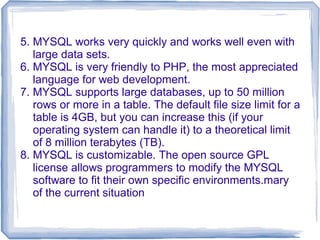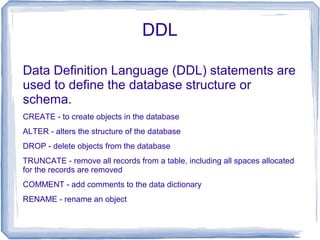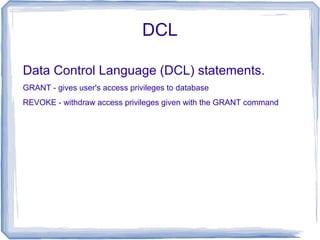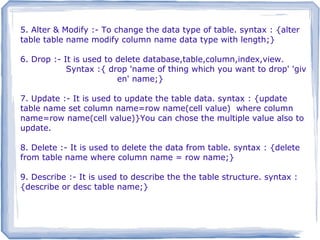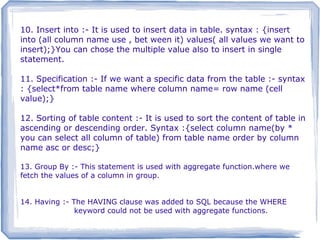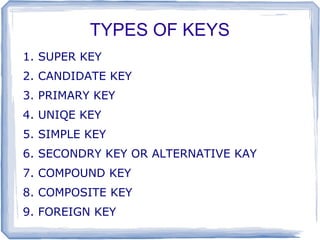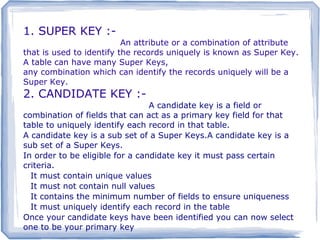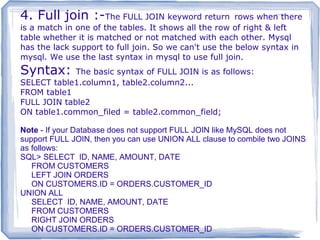Mysql database
- 1. MYSQL DATABASE ● BY THIS YOU CAN EASILY LEARN THE DATABASE. ● NOTES- BY MAYANK TIWARI
- 2. MYSQL DATABASE 1. INTRODUCTION OF MYSQL DATABASE 2. TYPES OF DATABASE 3. ADVANTAGE OF MYSQL DATABASE 4. MYSQL QUERIES 5. MYSQL CLAUSE 6. MYSQL OPERATORS 7. MYSQL JOINS 8. MYSQL KEYS 9. MYSQL DATATYPES
- 3. INTRODUCTION OF MYSQL DATABASE 1. Database is the collection of data, information & records in a organized way. 2. All database used SQL that is structural query language. If you want to deal with the database you used the query language.(query is the instruction to the database given by developer or query is just the syntax you written in a language.)(structural query means you write the syntax step by step or a structural foam.) 3. Database is just like pointer who store the value,change the value,get the value,post the value 4. We use data base for storing the DATAINFORMATION into it. 5. MYSQL database is the collection of data, information & records in the form of tables,with related data.
- 4. TYPES OF DATABASE RDBMS :- 1. MYSQL DATABASE. 2. MS SQL SERVER. 3. DB2. 4. ORACLE SERVER. 5. MS ACCESS. Note - {Syntax of Queries in php :- join->clause- >conditional operatores->group by ->order by.} Note – All the sql quary syntax are written on that page. http://www.w3schools.com/sql/sql_quickref.asp
- 5. ADVANTAGE OF MYSQL DATABASE 1. MYSQL is released under an open-source license. So you have nothing to pay to use it. 2. MYSQL is a very powerful program in its own right. It handles a large subset of the functionality of the most expensive and powerful database packages. 3. MYSQL uses a standard form of the well-known SQL data language. 4. MYSQL works on many operating systems and with many languages including PHP, PERL, C, C++, JAVA etc.
- 6. 5. MYSQL works very quickly and works well even with large data sets. 6. MYSQL is very friendly to PHP, the most appreciated language for web development. 7. MYSQL supports large databases, up to 50 million rows or more in a table. The default file size limit for a table is 4GB, but you can increase this (if your operating system can handle it) to a theoretical limit of 8 million terabytes (TB). 8. MYSQL is customizable. The open source GPL license allows programmers to modify the MYSQL software to fit their own specific environments.mary of the current situation
- 7. MYSQL QUERIES What is DDL, DML and DCL? 1. Data Definition Language deals with database schemas and descriptions of how the data should reside in the database, therefore language statements like CREATE TABLE or ALTER TABLE belong to DDL. 2. DML deals with data manipulation, and therefore includes most common SQL statements such SELECT, INSERT, etc. 3. Data Control Language includes commands such as GRANT, and mostly concerns with rights, permissions and other controls of the database system.
- 8. DDL Data Definition Language (DDL) statements are used to define the database structure or schema. CREATE - to create objects in the database ALTER - alters the structure of the database DROP - delete objects from the database TRUNCATE - remove all records from a table, including all spaces allocated for the records are removed COMMENT - add comments to the data dictionary RENAME - rename an object
- 9. DML Data Manipulation Language (DML) statements are used for managing data within schema objects. SELECT - retrieve data from the a database INSERT - insert data into a table UPDATE - updates existing data within a table DELETE - deletes all records from a table, the space for the records remain MERGE - UPSERT operation (insert or update) CALL - call a PL/SQL or Java subprogram EXPLAIN PLAN - explain access path to data LOCK TABLE - control concurrency
- 10. DCL Data Control Language (DCL) statements. GRANT - gives user's access privileges to database REVOKE - withdraw access privileges given with the GRANT command
- 11. MYSQL QUERIES 1. Create database :- To create database & table. Syntax : {create database database name;} {CREATE TABLE authors (id INT, name VARCHAR(20), email VARCHAR(20));} 2. Show :- To show the database & table you have. Syntax : {show databases ;}{show table;} 3. Use :- To use data base. syntax : {use data base name;} 4. select * :- This is used to show the detail information of table. syntax : {select*from table name} 5. Like :- It is used to get the data from the table which is most
- 12. 5. Alter & Modify :- To change the data type of table. syntax : {alter table table name modify column name data type with length;} 6. Drop :- It is used to delete database,table,column,index,view. Syntax :{ drop 'name of thing which you want to drop' 'giv en' name;} 7. Update :- It is used to update the table data. syntax : {update table name set column name=row name(cell value) where column name=row name(cell value)}You can chose the multiple value also to update. 8. Delete :- It is used to delete the data from table. syntax : {delete from table name where column name = row name;} 9. Describe :- It is used to describe the the table structure. syntax : {describe or desc table name;}
- 13. 10. Insert into :- It is used to insert data in table. syntax : {insert into (all column name use , bet ween it) values( all values we want to insert);}You can chose the multiple value also to insert in single statement. 11. Specification :- If we want a specific data from the table :- syntax : {select*from table name where column name= row name (cell value);} 12. Sorting of table content :- It is used to sort the content of table in ascending or descending order. Syntax :{select column name(by * you can select all column of table) from table name order by column name asc or desc;} 13. Group By :- This statement is used with aggregate function.where we fetch the values of a column in group. 14. Having :- The HAVING clause was added to SQL because the WHERE keyword could not be used with aggregate functions. 10. SQL Having9. SQL Group By 10. SQL Having9. SQL Group By
- 14. MYSQL CLAUSE 1. where :- Use to go on the table row position. Or cell position. 2. From :- It is used to difine table name by using from. 3. To :- It is also for our convienace. 4. Add :- To add the column in the table. 5. Top :- The TOP clause is used to specify the number of records to return.The TOP clause can be very useful on large tables with thousands of records. Returning a large number of records can impact on performance. Note: Not all database systems support the TOP clause. SQL Server Syntax {SELECT TOP number|percent column_name(s) FROM table_name} {SELECT TOP 2 * FROM table name;} 6. Having :- This clause is used with group by statement. Its also a conditional operator.
- 15. MYSQL OPERATORS 1. Conditional operators(AND,OR,NOT) :- That are use to show the data which is dependent on condition. Syntax :{update table name set column name=value where column name=value and column name =value;} same for or. 2. Union operator :- It is used to combine all the tables in database & represented all tables data in a single table foam. Syntax : { select column name(for all column use * at the place of column name) from table name union select*from table name;} it's not showing the repeated data. But for all the repeated data use union all at the place of union. 3. Between :- The BETWEEN operator is used in a WHERE clause to select a range of data between two values. 4. In :- The IN operator allows you to specify multiple values in a WHERE clause.syntax :{ SELECT column_name(s)FROM table_name WHERE column_name IN (value1,value2,...)} 5. Like :- The LIKE operator is used in a WHERE clause to search for a specified pattern in a column.
- 16. MYSQL KEYS 1. KEYS ARE DIFINE IN the tables to FETCH THE UNIQE DATA. 2. You make so many keys in a table according to your requirement.
- 17. TYPES OF KEYS 1. SUPER KEY 2. CANDIDATE KEY 3. PRIMARY KEY 4. UNIQE KEY 5. SIMPLE KEY 6. SECONDRY KEY OR ALTERNATIVE KAY 7. COMPOUND KEY 8. COMPOSITE KEY 9. FOREIGN KEY
- 18. 1. SUPER KEY :- 2. CANDIDATE KEY :- 3. SIMPLE KEY :- 1. SUPER KEY :- An attribute or a combination of attribute that is used to identify the records uniquely is known as Super Key. A table can have many Super Keys,. any combination which can identify the records uniquely will be a Super Key. 2. CANDIDATE KEY :- A candidate key is a field or combination of fields that can act as a primary key field for that table to uniquely identify each record in that table. A candidate key is a sub set of a Super Keys.A candidate key is a sub set of a Super Keys. In order to be eligible for a candidate key it must pass certain criteria. It must contain unique values It must not contain null values It contains the minimum number of fields to ensure uniqueness It must uniquely identify each record in the table Once your candidate keys have been identified you can now select one to be your primary key
- 19. 4. SECONDRY OR ALTERNATIVE KAY :- 5. COMPOUND KEY :- 6. COMPOSITE KEY :- 3. SIMPLE KEY :-A simple key consists of a single field to uniquely identify a record.primary key is also known as simple key. 4. SECONDRY KEY OR ALTERNATIVE KAY :- The attributes that are not even the Super Key but can be still used for identification of records (not unique) are known as Secondary Key. Alternate Key can be any of the Candidate Keys except for the Primary Key. It is a subset of candidate key. 5. COMPOUND KEY :-A Combination of more than one column identifying records of a table uniquely, all the columns that take part in the combination process are Simple Key’s. 6. COMPOSITE KEY :- If we use multiple attributes to create a Primary Key then that Primary Key is called Composite Key. In this all the other columns that take part in the combination process are not simple key's.
- 20. PRIMARY KEY 1. The PRIMARY KEY constraint uniquely identifies each record in a database table. 2. Primary keys must contain unique values. 3. A primary key column cannot contain NULL values. 4. Each table should have a primary key, and each table can have only ONE primary key. NOTE - YOU CAN REMOVE KEY BY ALTER & DROP AND ADD BY ALTER.& CONSTRAINT IS ALSO THERE.
- 21. UNIQUE KEY 1. The UNIQUE constraint uniquely identifies each record in a database table. 2. The UNIQUE and PRIMARY KEY constraints both provide a guarantee for uniqueness for a column or set of columns. 3. A PRIMARY KEY constraint automatically has a UNIQUE constraint defined on it. 4. Note - that you can have many UNIQUE constraints per table, but only one PRIMARY KEY constraint per table.
- 22. FOREIGN KEY 1. A FOREIGN KEY in one table points to a PRIMARY KEY in another table. CREATE TABLE SECOND TABLE NAME(COLUMN 1 int NOT NULL,COLUMN 2 int NOT NULL,COLUMN 3 int,PRIMARY KEY (SECOND TABLE COLUMN 1),FOREIGN KEY (COLUMN 1 IN TABLE FIRST) REFERENCES FIRST TABLE NAME (COLUMN 1 IN)) NOTE – FOREIGN KEY STABILISED THE RELATION BETWEEN TWO TABLES WHICH CONTAINS THE AT LEAST ONE SAME COLUMN. WE CAN ADD & DELETE THE FOREIGN KEY BY ALTER & DROP QUIREY.
- 23. MYSQL JOINS 1. JOINS ARE USE TO JOIN THE TABLES. & FETCH THE DATA OF DIFFERENT TABLES WHICH ARE RELATED BY AT LEAST ONE SIMILAR COLUMN BY SINGLE TABLE.In simple words joins are join the tables. 2. The JOIN keyword is used in an SQL statement to query data from two or more tables, based on a relationship between certain columns in these tables. 3. Tables in a database are often related to each other with keys. 4. A primary key is a column (or a combination of columns) with a unique value for each row. Each primary key value must be unique within the table. The purpose is to bind data together, across tables, without repeating all of the data in every table. 5. SQL joins are used to query data from two or more tables, based on a relationship between certain columns in these tables.
- 24. Types of joins 1. Inner join 2. Outer join 3. Full join 2. Outer join :- 1. Left outer join 2. Right outer join
- 25. 1. Inner join :-The INNER JOIN keyword returns rows when there is at least one match in both tables. SQL INNER JOIN Syntax SELECT column_name(s) FROM table_name1 INNER JOIN table_name2 ON table_name1.column_name=table_name2.column_name 2. Left outer join :-The LEFT JOIN keyword returns all rows from the left table (table_name1), even if there are no matches in the right table (table_name2).
- 26. SQL LEFT JOIN Syntax SELECT column_name(s) FROM table_name1 LEFT JOIN table_name2 ON table_name1.column_name=table_name2.column_name PS: In some databases LEFT JOIN is called LEFT OUTER JOIN. 3. Right outer join :-The RIGHT JOIN keyword returns all the rows from the right table (table_name2), even if there are no matches in the left table (table_name1). SQL RIGHT JOIN Syntax SELECT column_name(s) FROM table_name1 RIGHT JOIN table_name2 ON table_name1.column_name=table_name2.column_name PS: In some databases RIGHT JOIN is called RIGHT OUTER JOIN.
- 27. 4. Full join :-The FULL JOIN keyword return rows when there is a match in one of the tables. It shows all the row of right & left table whether it is matched or not matched with each other. Mysql has the lack support to full join. So we can't use the below syntax in mysql. We use the last syntax in mysql to use full join. Syntax: The basic syntax of FULL JOIN is as follows: SELECT table1.column1, table2.column2... FROM table1 FULL JOIN table2 ON table1.common_filed = table2.common_field; Note - If your Database does not support FULL JOIN like MySQL does not support FULL JOIN, then you can use UNION ALL clause to combile two JOINS as follows: SQL> SELECT ID, NAME, AMOUNT, DATE FROM CUSTOMERS LEFT JOIN ORDERS ON CUSTOMERS.ID = ORDERS.CUSTOMER_ID UNION ALL SELECT ID, NAME, AMOUNT, DATE FROM CUSTOMERS RIGHT JOIN ORDERS ON CUSTOMERS.ID = ORDERS.CUSTOMER_ID
- 28. MYSQL DATATYPES MYSQL has many different data types, separated into three categories: numeric, date and time, and string types. 1. Numeric Data Types :- 1. INT - A normal-sized integer that can be signed or unsigned. If signed, the allowable range is from -2147483648 to 2147483647. If unsigned, the allowable range is from 0 to 4294967295. You can specify a width of up to 11 digits. 2. TINYINT - A very small integer that can be signed or unsigned. If signed, the allowable range is from -128 to 127. If unsigned, the allowable range is from 0 to 255. You can specify a width of up to 4 digits. 3. SMALLINT - A small integer that can be signed or unsigned. If signed, the allowable range is from -32768 to 32767. If unsigned, the allowable range is from 0 to 65535. You can specify a width of up to 5 digits. 4. MEDIUMINT - A medium-sized integer that can be signed or unsigned. If signed, the allowable range is from -8388608 to 8388607. If unsigned, the allowable range is from 0 to 16777215. You can specify a width of up to 9 digits.
- 29. 2. Date and Time Types :- 1. DATE - A date in YYYY-MM-DD format, between 1000-01-01 and 9999-12- 31. For example, May 15, 1985 would be stored as 1985-05-15. 2. DATETIME - A date and time combination in YYYY-MM-DD HH:MM:SS format, between 1000-01-01 00:00:00 and 9999-12-31 23:59:59. For example, 4:30 in the afternoon on December 25th, 1980 would be stored as 1980-12-25 16:30:00. 3. TIMESTAMP - A timestamp between midnight, January 1, 1970 and sometime in 2037. This looks like the previous DATETIME format, only without the hyphens between numbers; 3:30 in the afternoon on December 30th, 1973 would be stored as 19731230153000 ( YYYYMMDDHHMMSS ). 4. TIME - Stores the time in HH:MM:SS format. 5. YEAR(M) - Stores a year in 2-digit or 4-digit format. If the length is specified as 2 (for example YEAR(2)), YEAR can be 1970 to 2069 (70 to 69). If the length is specified as 4, YEAR can be 1901 to 2155. The default length is 4.
- 30. 3. String Types :- 1. CHAR(M) - A fixed-length string between 1 and 255 characters in length (for example CHAR(5)), right-padded with spaces to the specified length when stored. Defining a length is not required, but the default is 1. 2. VARCHAR(M) - A variable-length string between 1 and 255 characters in length; for example VARCHAR(25). You must define a length when creating a VARCHAR field. 3. BLOB or TEXT - A field with a maximum length of 65535 characters. BLOBs are "Binary Large Objects" and are used to store large amounts of binary data, such as images or other types of files. Fields defined as TEXT also hold large amounts of data; the difference between the two is that sorts and comparisons on stored data are case sensitive on BLOBs and are not case sensitive in TEXT fields. You do not specify a length with BLOB or TEXT.
- 31. 4. TINYBLOB or TINYTEXT - A BLOB or TEXT column with a maximum length of 255 characters. You do not specify a length with TINYBLOB or TINYTEXT. 5. MEDIUMBLOB or MEDIUMTEXT - A BLOB or TEXT column with a maximum length of 16777215 characters. You do not specify a length with MEDIUMBLOB or MEDIUMTEXT. 6. LONGBLOB or LONGTEXT - A BLOB or TEXT column with a maximum length of 4294967295 characters. You do not specify a length with LONGBLOB or LONGTEXT. 7. ENUM - An enumeration, which is a fancy term for list. When defining an ENUM, you are creating a list of items from which the value must be selected (or it can be NULL). For example, if you wanted your field to contain "A" or "B" or "C", you would define your ENUM as ENUM ('A', 'B', 'C') and only those values (or NULL) could ever populate that field.
- 32. MYSQL FUNCTIONS -: AGGREGATE FUNCTIONS :- SQL aggregate functions return a single value, calculated from values in a column. 1. SQL avg() 2. SQL count() 3. SQL first() 4. SQL last() 5. SQL max() 6. SQL min() 7. SQL sum() -:SCALAR FUNCTIONS :- SQL scalar functions return a single value, based on the input value. 1. SQL ucase() 2. SQL lcase() 3. SQL mid() 4. SQL len() 5. SQL round() 6. SQL now() 7. SQL format()
- 33. AGGREGATE FUNCTIONS AVG() - Returns the average value COUNT() - Returns the number of rows FIRST() - Returns the first value LAST() - Returns the last value MAX() - Returns the largest value MIN() - Returns the smallest value SUM() - Returns the sum of column values
- 34. SCALAR FUNCTIONS UCASE() - Converts a field to upper case LCASE() - Converts a field to lower case MID() - Extract characters from a text field LEN() - Returns the length of a text field ROUND() - Rounds a numeric field to the number of decimals specified NOW() - Returns the current system date and time FORMAT() - Formats how a field is to be displayed
- 35. NORMALIZATION Normalization is the by which we refine the data or fillter the data with uniqueness. Normalization is the process where a database is designed in a way that removes redundancies, and increases the clarity in organizing data in a database. Minimize data redundancy i.e. no unnecessarily duplication of data. To make database structure flexible i.e. it should be possible to add new data values and rows without reorganizing the database structure. Data should be consistent throughout the database i.e. it should not suffer from following anomalies. Insert Anomaly - Due to lack of data i.e., all the data available for insertion such that null values in keys should be avoided. This kind of anomaly can seriously damage a database
- 36. Update Anomaly - It is due to data redundancy i.e. multiple occurrences of same values in a column. This can lead to inefficiency. Deletion Anomaly - It leads to loss of data for rows that are not stored else where. It could result in loss of vital data. Complex queries required by the user should be easy to handle. On decomposition of a relation into smaller relations with fewer attributes on normalization the resulting relations whenever joined must result in the same relation without any extra rows. The join operations can be performed in any order. This is known as Lossless Join decomposition. The resulting relations (tables) obtained on normalization should possess the properties such as each row must be identified by a unique key, no repeating groups, homogenous columns, each column is assigned a unique name etc.
- 37. TYPES OF NORMAL FORM 1. 1st Normal Form or 1NF 2. 2nd Normal Form or 2NF 3. 3nd Normal Form or 3NF 4. BCNF (Boyce & Codd) 5. 4NF 6. 5NF 7. 6NF





